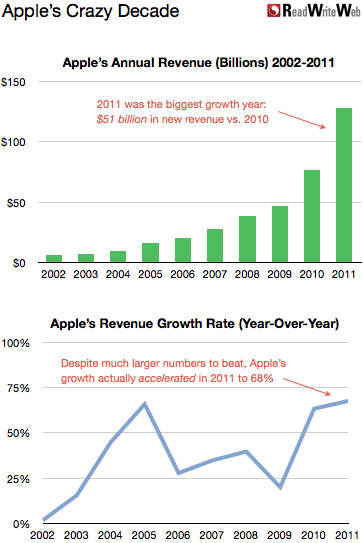Apple shares set another all-time high today, closing above $509 for the first time ever. The sky’s the limit, it seems, as expectations build around Apple’s new iPad, due next month, and on the heels of a crazy record holiday quarter.

And here’s an amazing thing: Even with Apple’s size and momentum, there’s still plenty of room left for growth. In its most important markets – mobile phones and personal computers – Apple is still being dramatically outsold by competitors.
That in mind, it’s also reasonable to ask: How long can Apple keep its streak alive? When will it peak?

First, Let’s Look Back
Apple’s current growth streak just finished its tenth year.
After a few years of ups-and-downs after Steve Jobs re-joined Apple, 2002 represented its sustained return to growth. That was the first full year of iPod sales, an okay year for the Mac, and Apple brought in $5.8 billion in total sales, up 2% from 2001. (That said, it was still a pretty bad time for the tech and PC industries, following the dot-com bust.)
Since then, Apple has posted full-year revenue growth every year, now for ten years in a row.
In 2011, Apple reported $128 billion in sales, up 68% from 2010 – an accelerating growth rate. The weakest growth years were 2003 (16% growth) and 2009 (20% growth) – two “bad” years that most tech companies would love to have. The last two years have been nothing short of incredible, led by Apple’s booming iPhone, iPad, and Mac businesses.
Still an Underdog
The crazy thing is that even considering how big Apple is, it’s still a relatively small player in many of its markets, at least measured by unit sales. That is, there’s plenty of future growth potential, just by convincing more people to buy Apple versions of the products they’re already buying.
In the mobile phone market, for instance, Apple only represented 4% of global phone shipments in the third quarter of 2011, according to Gartner. (Its fourth quarter share will almost certainly be higher, as the iPhone had a huge Christmas, but still probably not more than 8% of the total market.) Rival Nokia, meanwhile, still shipped 24% of the world’s phones in the third quarter.
In personal computers, despite record Mac sales over the holidays, Apple wasn’t even big enough to make it into Gartner’s top five worldwide vendor list. A reasonable estimate is that if you only count Apple’s Mac sales, it represented about 6% of the PC market last quarter. If you also include iPads, Apple’s share rises to around 19%. But even then, that still means more than 4 of every 5 PCs sold in the world are non-Apple machines.
So Apple’s opportunity to keep growing is obvious: All it needs to do is to keep representing a higher share of sales in its key, fast-growing markets – smartphones and tablets. That, combined with new potential growth areas like TVs, should offset its shrinking iPod business and slower-growing Mac business.
But there are two big hurdles/risks that Apple is going to have to deal with:
- Apple is a premium brand, and as much as Apple is defining taste in electronics and teaching more people to want to buy premium products, that’s never going to represent 100% of any market. So at some point, Apple’s addressable part of any market will hit its limit.
- One of the key things that makes Apple successful is its narrow, deliberate focus, and its relative lack of bloat. Nonstop growth, even under the smartest and most efficient of leaders, challenges those traits.
So, When Will Apple Peak?
Barring economic disaster, it seems Apple is set to maintain yearly sales growth at least through the end of this decade. Its position in its current technology cycle – smartphones and tablets, and perhaps TVs – seems strong enough to suggest that Apple should be able to sell more stuff every year than it did the year before for at least that long. The main risk seems to be Google’s Android ecosystem, which will challenge Apple’s iOS in seemingly every market. But so far, Apple seems to be fine.
The bigger question is: What comes after that? Can Apple transform its iPhone and iPad into whatever comes after them, the way it morphed the iPod and Mac into its current lineup? And that’s where the unknown is simply unknown. It’s possible that sometime in the 2020s – if not sooner – Apple will have its first down year since 2001.










